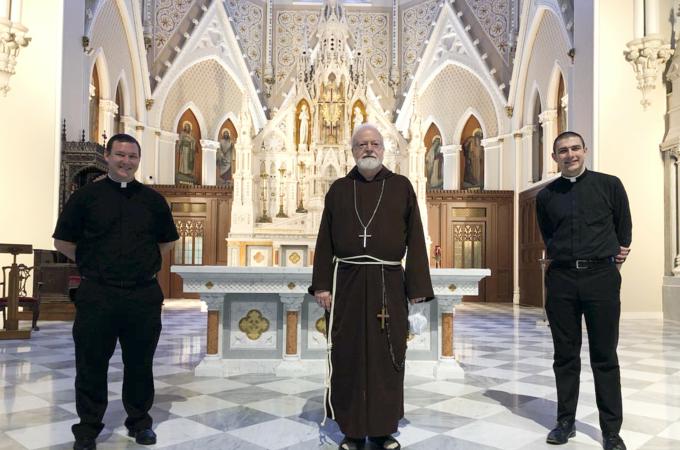From Cardinal Seán's blog
This last week, we were happy to be visited at the cathedral by one of our seminarians studying at the Pontifical North American College in Rome, Joe Ferme. Joe had not been home for a couple of years, and this was his first chance to see the renovations to the cathedral in person. So, Father Kevin Leaver brought him over to see them.
Of course, he was very, very pleased to see how beautiful the cathedral came out. I told him we had it renovated in anticipation of his ordination!
Hagia Sophia
In 2007, Metropolitan Methodios and I led a wonderful Catholic-Orthodox pilgrimage to Rome, Constantinople, and St. Petersburg with about 100 Catholic and Orthodox priests and laypeople. One of the highlights of the trip was meeting with Ecumenical Patriarch Bartholomew in Constantinople and visiting the Hagia Sophia, the former Patriarchal Cathedral.
The Hagia Sophia was built by the Emperor Justinian at a time when the Catholic and Orthodox Churches were still united. I was thrilled to climb the pulpit from which St. John Chrysostom used to preach and see the beautiful mosaics throughout the former cathedral.
When it was built, it was the largest building in the world and retained that title for many, many years. There were, literally, tons of gold used in the mosaics on the ceiling.
It is just a spectacular structure steeped in so much history. For nearly a thousand years, it was a Christian Cathedral of Constantinople. Then, under the Ottoman Empire, it was converted into a mosque. In the 20th century, Kemal Ataturk, the founder of the modern Turkish republic, decided to turn the Hagia Sophia into a secular museum. I understand that it is the most visited site in Turkey, attracting over 4 million people a year.
The decision by the Turkish government to once again convert the Hagia Sophia into a mosque is very distressing for Christians throughout the world, but particularly for the Greek Orthodox. There are, of course, concerns that the move will make access to the Hagia Sophia more difficult, and there is also a question as to what might happen to the mosaics and icons that adorn the building.
In light of these concerns, I was happy to join Metropolitan Methodios in issuing a statement on the matter, which can be found on my blog.
Resumption of executions
As Catholics, our commitment to life is at the center of our Social Gospel. Of course, this begins with the defense of life in the womb, but ours is a consistent life ethic, meaning that we stand in defense of human life whenever it is threatened or vulnerable. There may be other groups that are pro-abortion and against the death penalty, or vice versa, but the Catholic Church stands in defense of all human life -- particularly, where life is most vulnerable and least valued by society.
Part of our commitment to life expresses itself in the Church's opposition to the death penalty, which, in the past, was tolerated as a form of societal self-defense. However, particularly since Pope John Paul II, the Church's position has been that, in the modern world, life is too precious to be taken by the state, particularly, when it is possible to adequately incarcerate dangerous criminals and isolate them from society.
In the United States, I think we have seen that the death penalty has often been applied unevenly against the poor and minority groups and, at times, it has even been mistakenly imposed -- people have been executed, and afterward, it is discovered that they were innocent. Of course, there is no way to redress that wrong.
The United States is one of the few countries in the world that still has the death penalty. In fact, when Pope Francis made his very eloquent address to the joint session of Congress in 2015, the Holy Father chose to speak on this particular aspect of the Church's commitment to the sacredness of life.



















